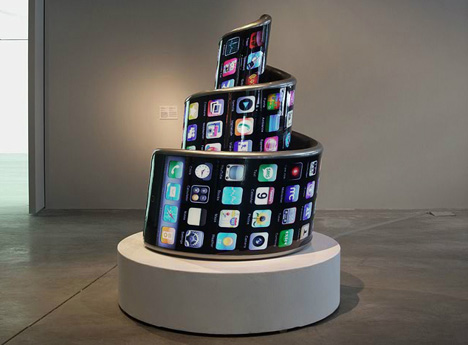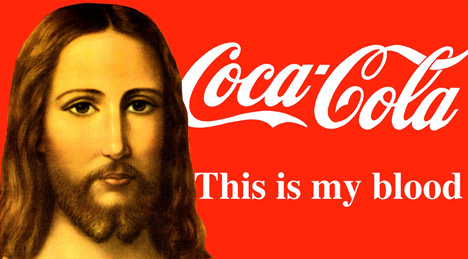

Source: Press photo
Coca-Cola as a sponsor of communism
Alexander Kosolapov's paintings combine images from different ideological systems, the capitalist and the communist one. In one of his pictures, the name Coca-Cola sits next to a Lenin portrait and the caption reads: "It's the real thing." The painting turned out to be so provocative that the company accused the artist of stealing its brand and of creating the impression that Coca-Cola was sponsoring communism.
Kosolapov's other works are no less controversial. For example, in the diptych called This Is My Blood / This Is My Body, he superimposes Christ's face onto the Coca-Cola and McDonald's brand names respectively. Or take The Angel of Cholesterol, a sculpture of a modern man with his arms outstretched as in a crucifixion and a big letter M, famous all over the world as the symbol of the popular fast-food chain, behind his back as his wings.
Yet another of Kosolapov's works, called Caviar Icon and depicting the metal cover of a traditional Russian icon filled with black caviar, was removed from an exhibition at the Tretyakov Gallery following protests by Russian Orthodox activists. Kosolapov himself insists that this work was just a reply to Andy Warhol, who wrote that democracy arises out of consumerism.
Ten Facebook commandments
Source: Press photo
Young artists from the group Recycle have also turned their thoughts to sacred themes. Their project, Paradise Network, is devoted to Facebook. As far as they are concerned, the global social network is not just a communication tool but a new social institution with its values and ideals, traditions and rituals, with its own religion.
"What will our era leave in history?” the artists wonder. “What makes this era different from the previous ones is that it lives not only in real time but also in a virtual space." Data that makes it into that virtual world does not disappear; people continue to live on their social network pages even after they have died. Paradise Network features a huge letter F, resembling a memorial cross. A symbol of the new religion, it is accompanied by the "Tablets of the Covenant" with the 10 modern commandments, bearing a direct resemblance to social network site rules. After all, if you break Facebook’s rules, access to your account will be blocked and you will be forbidden from living an eternal life inside the social network.
3G International

Source: Press photo
Apple is one of the brands that has given food for thought to artists from the Electroboutique group. Their light sculpture called 3G International is an allusion to several cultural phenomena at the same time. A gigantic iPhone is rolled into a version of Vladimir Tatlin's Monument to the Third International. As the artists themselves explain, Tatlin's Tower is an icon of Russian avant-garde art, while the iPhone is a technological icon of today. A century ago, avant-garde artists invented design in order to bring art into people's everyday lives. Today many companies claim that their products are works of art in themselves. 3G International is the quintessence of a dialogue between art and design.
On the other hand, this image is also an allusion to the Tower of Babylon. "An iPhone is the embodiment of Babylon today,” say the Electroboutique collective. “It is a mixture of languages, instant access to all the information in the world, a universe in one's pocket. It fills the consumer with the illusion of omnipotence, which turns into a Babel of Babylon in their heads."
Nine cars on fire
Source: Press photo
Artists Maria Zaborovskaya and Andrei Lyublinsky work in an area which is a cross between modern art and design. Their project has been prompted by the events in France in 2005, when riots erupted in the Arab-populated districts of Paris and other cities. Some of the most striking images from those riots were cars, as a symbol and a fetish of consumer society, blown up or set on fire. The artists have created nine objects looking like neat and stylish toy cars with plumes of fire coming out of them. Each of the nine cars bears a world famous brand name: Coca-Cola, Martini, Lacoste, McDonald's, Heineken, Barbie, IKEA, Pepsi, and Nike. However, the simple outlines of the objects, their laconic and even naïve nature, have turned them into detached symbols, a brand of a horrific event as it were.
The author is an art critic.
All rights reserved by Rossiyskaya Gazeta.
Subscribe
to our newsletter!
Get the week's best stories straight to your inbox